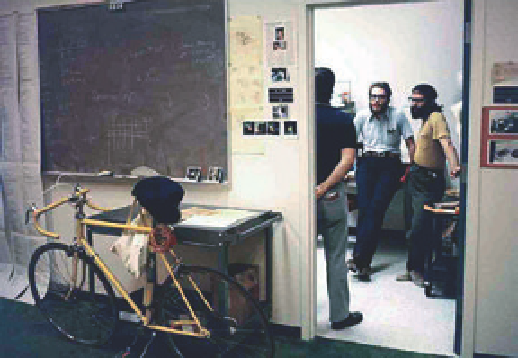Information Technology Reference
In-Depth Information
Fig. 8.1. Eager to be known as more
than a supplier of office copiers, Xerox
created PARC in 1970. PARC's mission
was to create the “Office of the Future.”
George Pake and Bob Taylor assembled
a team of world-class scientists and
engineers - to create the “architecture
of information” - and PARC became a
hothouse of innovation that flourished
for decades. The atmosphere at Xerox
PARC reflected the laid-back, West Coast,
hippie-influenced culture of the 1970s.
It was worlds apart from the culture
of Xerox's corporate headquarters in
Connecticut. In an unrivaled burst of cre-
ativity, the PARC researchers developed
most of the personal computing environ-
ment that is still with us today - overlap-
ping windows, GUIs, Ethernet, digital
video, word processing, and laser print-
ers. Although PARC's inventions never
led to a successful personal computer
business for Xerox and many ideas never
became successful commercial products,
the laser printer alone generated billions
of dollars in sales for Xerox, much more
than their total investment in PARC.
the TX-0 from their off-campus Lincoln Laboratory site over to the main MIT
campus. Clark later wrote:
The only surviving computing system paradigm seen by MIT students and
faculty was that of a very large International Business Machine in a tightly
sealed Computation Center: the computer not as a
tool
, but as a
demigod
.
Although we were not happy about giving up the TX-0, it was clear that
making this small part of Lincoln's advanced technology available to a larger
MIT community would be an important corrective step.
3
Yet a third type of interactive computing was also being experimented with
at MIT. As we have seen, John McCarthy had become so frustrated with this
remote, batch processing model of computing that he had come up with the
idea of time sharing. Sharing the computing cycles of a single large computer
among several users, each connected to the computer with their own terminal,
introduced a different type of interactivity - one in which the user had the illu-
sion of being the sole user of the computer.
It was out of this hotbed of experimentation with interactive computing at
MIT that Lick was recruited in 1962 to lead a new computer research program
at the U.S. Department of Defense's Advanced Research Projects Agency (ARPA).
When he arrived at the Pentagon, Lick set about creating a major research
program in interactive computing - and in so doing laid the foundations for
much of the university computer science research in the United States. As we
will see in
Chapter 10
, Lick also had the idea of connecting remote computers
together to create what later became the ARPANET - although it was left to
Bob Taylor, one of Lick's successors at ARPA, to get the funding to implement
Lick's vision.
How did we get from these early explorations of interactive computing to
the personal computing we see around us today? In his topic
Dealers of Lightning:
Xerox PARC and the Dawn of the Computer Age
, Michael Hiltzik highlights the con-
tribution of the researchers at Xerox Corporation's Palo Alto Research Center
(PARC) (
Fig. 8.1
):

Search WWH ::

Custom Search